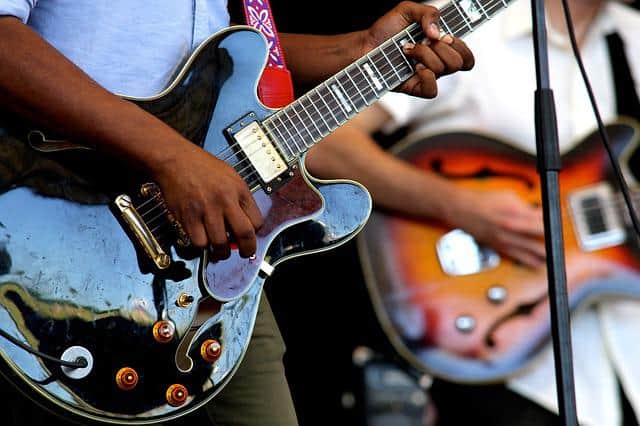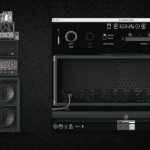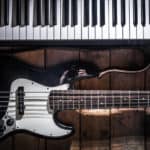I think most guitar players have experienced the high-e string slipping off of the fretboard a few times, especially when they were just starting out.
But if it keeps happening there could be a problem and unfortunately, there are quite a few things that could be causing it.
A guitar’s bridge, nut, neck alignment and fret ends are all possible causes of the first string slipping off of the fretboard easily. Since some of the potential repairs could exceed the value of the instrument, sometimes it might make sense to try adjusting your playing style or using heavier strings.
If you are new to playing guitar and having this problem, let’s try to determine if you are causing the problem before we get into troubleshooting the guitar.
After all, adjusting your playing is free and most of the other fixes will cost you some money if the guitar isn’t under warranty.
Is it normal for the first string to slip off of the guitar fretboard?
If an instrument is properly made and everything is in alignment the high-e string should not easily come off the fretboard.
So if you are just starting out or have recently switched from playing acoustic guitar to electric you might be unknowingly applying pressure downward that doesn’t affect heavier guitar strings so much.
You can try adjusting the posture of your wrist first to see if that helps or try a heavier gauge of strings.
I would also recommend getting a second opinion from another player or a luthier/guitar tech.
People who work on instruments tend to be pretty nice so they shouldn’t mind taking a quick look to see if your instrument needs repair.
What could be causing the first string to slip off of the fretboard?
There are a lot of things to check out if you have determined that the instrument is the problem.
The first thing to do is make sure that the string is sitting where it should be on the bridge saddle and it hasn’t been pushed out of the groove.
Also, make sure that the string is resting properly in the slot of the nut.
Take a careful look down the neck of the guitar and make sure that the strings remain parallel to the edge of the fretboard for the entire length.
Finally, take a close look at the fret ends to see if the first string has a flat section of fret to sit on and if it isn’t sliding off because it is touching the sloped end of the fret wire.
Is there a way of preventing the high e string from sliding off the fretboard?
Learning how to play with it
Before we dive into repairs there are a few more simple factors to consider.
First, if the high-e string comes off the neck when you are down tuning your guitar or using some kind of open tuning you may need to switch to heavier strings to compensate for the “slinkiness”.
However, if you get a used guitar and someone has put really heavy strings on it, this could be causing problems if the strings are too big for the nut slots.
As far as playing, some people complain that the first string slips off when they are doing pull-offs or vibrato.
If you experience that and you don’t want to spend money on the instrument, simply try to use the second string five frets higher instead.
After all, there are only five notes on the first string that you can’t play on the second string and most people don’t even use those notes often.
It’s like the joke where a guy goes to a doctor and says “Doc, it hurts when I do this” and the doctor replies “Then don’t do that.”
Modifying or changing your guitar’s nut
It’s not that uncommon for nuts to be poorly cut on a lot of budget guitars.
So if the nut slot doesn’t seem deep enough for the string and the string is slipping out you can have a guitar tech cut it deeper or maybe even try it yourself with a file.
However, if the slot is not in the correct place on the nut and holds the string too close to the edge of the fretboard then it should be replaced.
This is definitely something I recommend having done by a professional.
Modifying or changing your guitar’s bridge
Another area to check is the string saddle by the bridge.
If you play really aggressively it’s possible that you have pushed the string out of the groove it should rest in.
If it happens to you often and you don’t think it’s your playing that’s at fault then you should consider having the bridge set up (grooved) or replaced.
Also, make sure that when the string is seated that everything is aligned correctly (the bridge was installed properly).
Adjusting your guitar’s neck joint
Now if you have noticed that both your high-e and low-E strings come off of the fretboard easily your neck may be out of alignment in the pocket.
If you have a guitar with set-neck or through-neck construction I’m not sure if anything can be done.
But for Fender-style guitars with bolt-on necks, you should be able to loosen the bolts to get it straight and then re-tighten them or maybe use shims to get it right.
This one can be done at home for free but I would recommend checking out a video tutorial or guide first.
Refretting and letting frets stick out leaving a hard bevel
Now it’s time to tackle what is probably the most serious and potentially expensive problem: the frets.
If the frets are beveled (sloped) too far in from the edge, your strings can slide down and off the fretboard easily.
If your guitar is used and someone was overzealous in sanding down the sharp fret ends, (especially during cold weather when the wood has shrunk – when it is warmer and humid the wood can swell up slightly), you might need to consider having new frets installed.
Unfortunately, this is really expensive to do and may be more than the instrument is worth so think of it as a last resort.
You could try to save some money by having the frets dressed (reshaped) professionally but you can’t replace the fret wire that is already gone.
So if you do decide to have new frets installed you could consider asking for a more squared fret end or even leaving them slightly longer than normal.
It won’t be very comfortable if you slide your hand around the fretboard a lot when you play but you can always sand them down if it’s too bothersome.
All of the above
Hopefully, you have learned some useful tips on how to determine what’s causing the first string to slip off the neck.
And if you’re thinking about buying a used guitar with no warranty and this problem happens, this should help you decide if it would be a simple fix or a nightmare.
But depending on your confidence in repairing things, I think it makes sense to leave most of these repairs to the professionals who have the necessary tools and experience.

Hello there, my name is Ramiro and I’ve been playing guitar for almost 20 years. I’m obsessed with everything gear-related and I thought it might be worth sharing it. From guitars, pedals, amps, and synths to studio gear and production tips, I hope you find what I post here useful, and I’ll try my best to keep it entertaining also.





